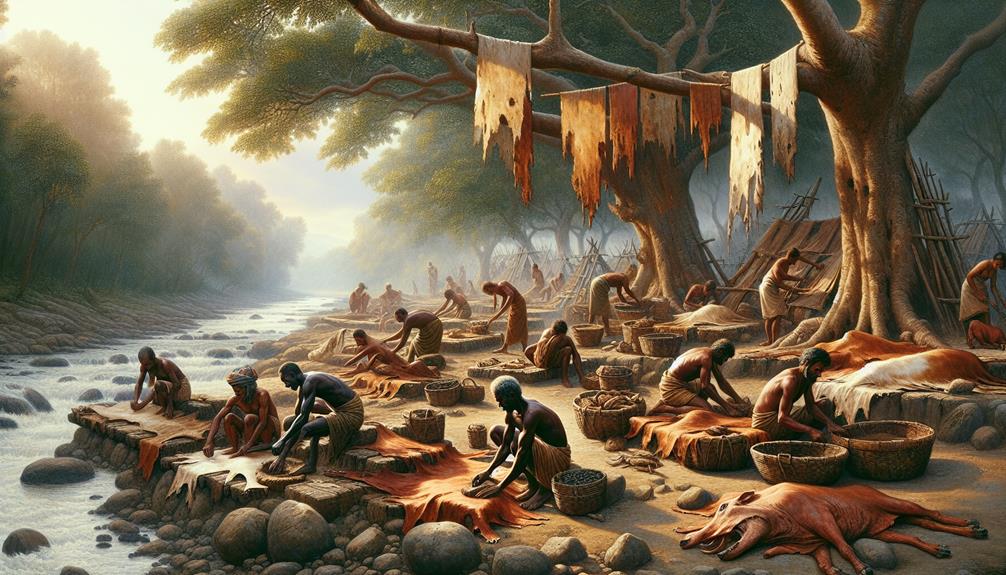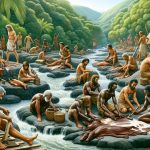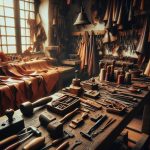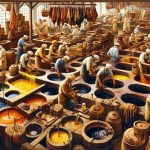Leather's been around for ages, dating back to when early humans used animal hides for clothing and protection. The real magic started with the Assyrians and Egyptians, who pioneered the first leather crafting techniques. They found out that tannin from oak bark could transform raw hides into durable, preserved leather. This know-how evolved over the centuries, majorly stepping up during the Industrial Revolution with the introduction of chromium tanning. Today, thanks to technological advances and global markets, leather production's pretty sophisticated. There's a lot more intriguing info about how these ancient methods have shaped modern leather crafting.
Table of Contents
Key Takeaways
- Leather originates from early human use for clothing and protection.
- Ancient civilizations refined tanning techniques using materials like tannin from oak bark.
- Assyrians and Egyptians were pioneers in early leather crafting.
- Leather's significance grew with its use in armor and as a status symbol in Medieval times.
- The introduction of chromium tanning during the Industrial Revolution modernized leather production.
Early Leather Use in History
Exploring the use of leather in early history, cave paintings in Lerida, Spain, show that our ancestors wore leather clothing. This indicates that leather wasn't just a modern luxury but a fundamental resource for survival. The need for leather arose naturally as humans used animal hides from their hunts. Initially, they wrapped themselves in these skins and hides to keep warm right after a kill.
By the time of the Bronze Age, leather production had become more refined. The discovery of a frozen Bronze Age hunter in the Alps, decked out in shoes made from bear and deer skin, shows just how essential leather was. It wasn't only about warmth; leather provided protection and durability that primitive fabrics couldn't.
These early uses of leather laid the groundwork for the leather industry as we know it today. The transformation of raw, uncured hides into usable leather was crucial. Without the tanning process—which I won't get into now—these skins and hides would either stiffen in cold or rot in heat. Clearly, our ancestors' ability to manipulate leather was a game changer, making leather a key player in human advancement and culture.
Tanning Techniques Evolution
How have tanning techniques evolved since ancient times? Well, let's dive into the fascinating world of tanning and its transformation! Originally, ancient civilizations like the Assyrians and Egyptians mastered the early art of leather craft. Their methods, though primitive, laid the groundwork for what would become a crucial part of leather production.
The real game-changer came with the discovery of tannin found in oak tree bark. This natural substance drastically improved the durability and quality of tanned leather goods. By the 12th century, these tanning methods had become more refined, allowing for a wider variety of leather goods to be produced and preserved.
Here's a simple table that breaks down the historical progress:
| Era | Discovery | Impact on Leather Craft |
|---|---|---|
| Ancient Assyrian | Early tanning | Pioneered basic leather preservation |
| Ancient Egyptian | Advanced techniques | Enhanced crafting of specific goods |
| Discovery of Tannin | Oak tree bark | Revolutionized tanning, improving durability and quality |
| 12th Century | Method refinement | Expanded variety in leather goods |
Each step in this evolution not only preserved more animal skins but also perfected the art and science of leather production. This journey from basic preservation to sophisticated tanning showcases the rich tapestry of innovation in human history.
Leather in Medieval Times
As we look back at the Middle Ages, it's clear that leather played a huge role, not just in daily life but in shaping society too.
Tanners were really stepping up their game, developing techniques that set the stage for some quality leather goods.
From sturdy armor to everyday clothing and gear, leather was essential and its craftsmanship was taken seriously.
Medieval Tanning Techniques
Medieval tanners relied on natural tannins from oak bark and other plants to cure leather effectively. It's fascinating how they mastered these tanning techniques to meet the high demand for various leather goods.
Here's a quick rundown of how they did it:
- Natural Ingredients: Skilled tanners used not just plant tannins but also urine and dung to process the hides. Sounds gross, but it worked wonders for preservation and softening!
- Guilds and Regulation: Tanning guilds popped up to ensure quality leather production, setting high standards that kept the craft in check.
- Finishing Touches: Post-tanning, craftsmen employed currying, infusing the leather with oils for that durable yet supple finish necessary for everyday use.
This blend of nature and skill defined medieval leather craftsmanship.
Armor and Clothing Uses
Leather was a game-changer in medieval times, primarily used to make protective armor and stylish clothing for knights and nobles. The tanning process and type of animal hide determined the quality of the leather, affecting both its durability and ability to offer protection.
Leather artisans were masters at their craft, creating intricate designs that not only enhanced the functionality of armor but also its prestige. This skill made leather items highly sought after by the elite of medieval society.
As both a practical material for battle and a symbol of status, leather's role in medieval clothing and armor was indispensable, showcasing the incredible impact of this versatile material on the lives and safety of those in medieval times.
Industrial Revolution Impact
The Industrial Revolution truly transformed how leather was produced, making it faster and more diverse. Back then, the introduction of machines and the chrome tanning method, using chromium sulfate, were game-changers.
Let me break down how these changes revolutionized the leather industry:
- Chromium Tanning: Introduced in 1858, this process used chromium sulfate to create softer, thinner leather. Unlike traditional methods, chromium tanning cut down production time dramatically, allowing for quicker turnaround times in manufacturing.
- Machinery: The use of machines in leather production meant more efficient processing. Tasks that had previously taken days could now be completed in hours. This wasn't just about speed; it also meant that leather products could be produced in larger quantities.
- Product Variety: With these industrial advancements, the variety of leather products expanded significantly. This wasn't just good news for consumers but also spurred further innovation within the industry, as manufacturers experimented with new types of leather goods.
The impact of the Industrial Revolution on leather production was profound. It set the stage for the modern leather industry, characterized by efficiency, innovation, and a wide array of products that we've come to rely on today.
Contemporary Leather Production
Today's leather production processes are heavily influenced by technology and global market trends. As a by-product of the meat industry, the availability of hides and skins directly ties to meat production. This means when you've got more meat being produced, there's more raw material for leather. Think about the major leather producers like Brazil, Argentina, the USA, Italy, India, and China. Each of these countries brings something unique to the table, often shaped by historical traditions.
In the leather manufacturing process, two main types of tanning stand out: Chrome tanning and vegetable tanning. Chrome tanning is by far the most prevalent, thanks to its efficiency and the durable leather it produces. It's a bit of a double-edged sword though, as it involves chemicals that can be harsh on the environment. On the other hand, vegetable tanning, which uses natural materials like tree bark, is seen as more environmentally friendly but is less commonly used due to its longer process time and higher costs.
Interestingly, while traditional uses like garments are declining, leather is increasingly in demand for furniture and car upholstery. This shift reflects changing consumer preferences and leather market dynamics, emphasizing durability and luxury.
Future Trends in Leathercraft
As we look ahead, sustainable alternatives like lab-grown leather are reshaping what the future of leathercraft might hold. The push for more eco-friendly materials comes from a deepening concern over environmental impacts and a shift in cultural values towards more ethical practices.
Here's what's catching my eye:
- Mushroom-Based Materials: These aren't only biodegradable but also offer a remarkable texture that can mimic traditional leather. It's fascinating to see how close these materials come to the real thing while being totally plant-based.
- Engineered Bacteria Textiles: This tech uses bacteria to produce sheets of cellulose, which are then processed into durable, leather-like materials. The cool part? They can be engineered to self-pigment, reducing the need for harmful dyes.
- Gelatine-Based Leather: Made from animal by-products, this type of leather promises to reduce waste. Its production process is designed to use lesser resources than traditional leather tanning, making it a smarter choice for the planet.
These innovations not only promise to keep our wardrobe fresh but also reflect a larger commitment to preserving our world. It's thrilling to see how these advancements align with growing ethical standards and could revolutionize our approach to fashion and beyond.
Frequently Asked Questions
What Animal Leather Came From?
I've learned that leather comes from animals like cattle, sheep, goats, pigs, and horses. Each type offers unique characteristics, making the leather diverse and versatile for various products.
Does Leather Come From Cows or Pigs?
Leather primarily comes from cows, but it can also come from pigs. Cowhide is favored for its durability and smooth texture, making it more popular for high-quality leather goods like jackets and shoes.
Is Leather Naturally Occurring?
Leather isn't naturally occurring; it's made from animal hides through a process called tanning. I've learned that this method transforms the skins into durable, usable material for various products like shoes and jackets.
What Country Is Known for Its Leather?
Italy's renowned for its high-quality leather, especially from regions like Tuscany and Veneto. Their craftsmanship dates back to Roman times, emphasizing luxury, durability, and innovative design in their globally exported goods.
- How Does Ring Spun Cotton Affect Garment Fit and Shape Retention? - August 13, 2024
- What Are the Challenges in Producing Ring Spun Cotton? - August 13, 2024
- Is Ring Spun Cotton Suitable for Plus-Size Clothing? - August 13, 2024







